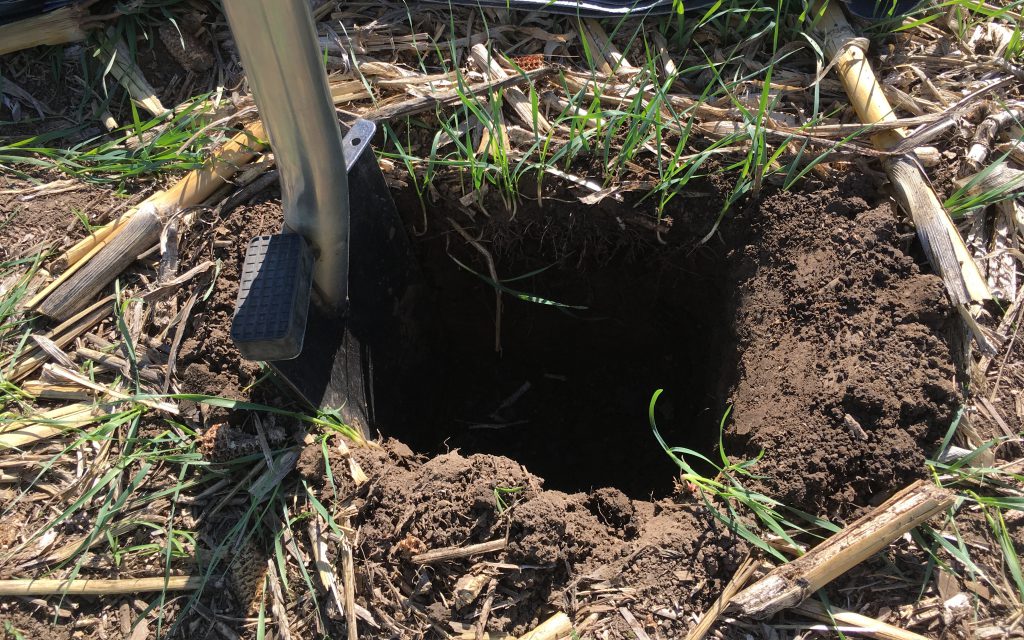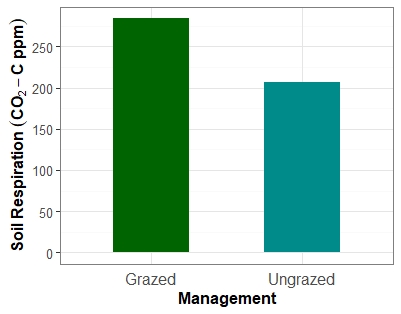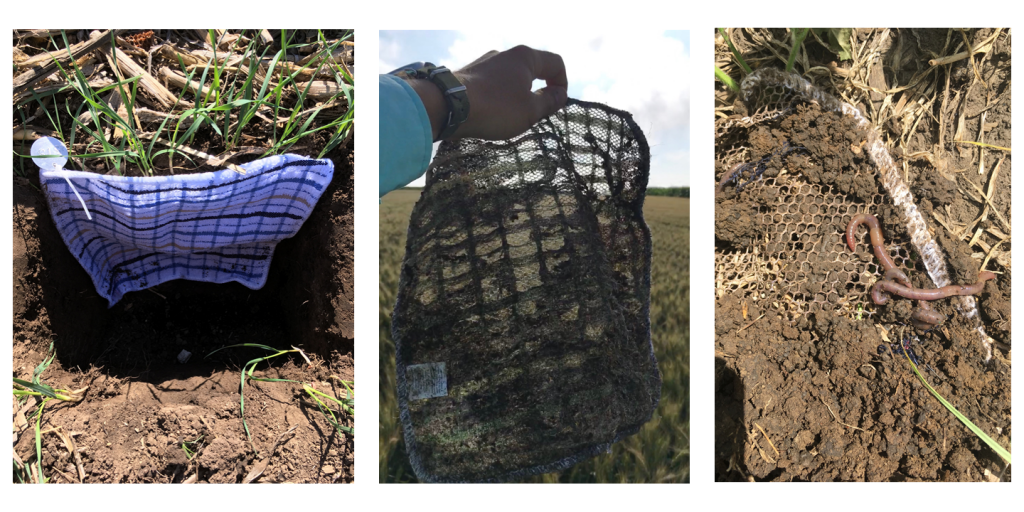
Visual inspection of a soil to gauge soil aggregates, crop root penetration, among other characteristics is one of many ways soil health can be assessed.
Soil health broadly refers to the quality of a soil in terms of chemical, physical, and biological characteristics. It includes conventional soil fertility considerations and adds to it a more holistic view of the soil by considering more dimensions of a soil (chemical, physical, and biological) than fertility alone. Within the philosophy of a soil health framework, soil is regarded as a living entity. In a figurative sense, how it is managed for sustainable production can be compared to the care, feeding, and tending one gives to livestock, as opposed to viewing it as simply a plot of dirt to be used.
The USDA’s Natural Resource and Conservation Service identifies 5 main principles of soil management that contribute to soil health: 1) Soil armor/cover – referring to soil coverage from crop and/or crop residues for protection from erosion and other forces; 2) Minimizing soil disturbance by utilizing minimum tillage management where possible; 3) Plant diversity – crop rotation and crop diversification to include a wider variety of crops; 4) Live plants and roots yearlong – through crop rotation or cover crops, avoid fallow periods to better support soil microbes and soil food webs with live growing roots in the soil constantly; and 5) Livestock integration– including grazing livestock in crop rotations to recycle cover crop plant material and crop residues into plant usable nutrients in livestock manure and urine. Implementing these soil health principles where possible in a farm’s agronomic management plan has been shown to lead to improvements in soil health.

Example of a comparison of a soil health lab test score of soil CO2 respiration in two cropland soils in Central North Dakota. One implementing a soil health principle practice of grazing livestock seasonally and one without livestock grazing. Soil CO2 respiration is a soil health indicator of soil microbiological activity and nutrient balances, higher scores indicating more activity of soil microbes and/or better balanced soil nutrients.
–
How is soil health measured?
Soil health is assessed in a variety of ways both formally and informally. Through informal observations one can notice how well water infiltrates after a rain in given field versus another, gauge relative degree of soil aggregation, or presence of earthworms from digging up a shovelful of soil. Farmers are likely informally gauging signs of soil health when they notice “that one field” or “piece of a field” that always performs (yields) better than the rest of the farm year after year.
In addition, soil health is assessed through formal in-field and laboratory tests. Examples of in-field formal assessments include using special instruments like a penetrometer to measure soil compaction, measuring rate of water infiltration with a known volume of water and a timer, burying pieces of cotton cloth for a set number of days to gauge soil microbial activity by how much of the cloth is decomposed after a few weeks, among others. Lab tests available for soil health also abound, measuring things such as soil organic matter, other soil chemical characteristics, as well as biological aspects.
Soil health test parameters differ from normal soil fertility testing in that their results are relative scores and don’t translate to a direct prescription for soil management like a fertilizer recommendation like one would get from a conventional soil fertility test. Instead, they are more useful for comparing and tracking progress of soil condition resulting from implementing improved practices over time. It is also important to note that most soil health test parameters are relative, and best interpreted in context of the location, soil type, topography, etc. of a given field. For instance, what is considered a “good” result will look quite different for Iowa converted prairie farmland, than the sandier soils we are familiar with in the southeast. Research is also still ongoing to better understand which of the many soil health indicators/tests are most useful for relating to production/yield for farmers within different regions.

One in-field measure of soil health is the “cotton strip soil test“. Pieces of cotton cloth (cotton dishcloths in this case) are buried in the soil for a set amount of time, such as a few weeks (Left). Then, retrieved later to gauge how much cloth was decomposed by soil microbes and other soil organisms as a metric of relative soil biological activity (Center and Right). Soil organisms ‘eating’ more of the material is a sign of greater relative biological activity–an indicator of a healthy ‘living’ soil.
–
How does soil health and soil health testing potentially translate to a value for a farmer?
In a recent study collaborating with row crop farmers in Michigan, fields scoring higher soil health lab test results were also ranked by farmers to be their best fields in terms of yield, perceived soil quality, reliability, and drainage. This shows the potential for soil health tests to be a useful tool for measuring and tracking soil characteristics that correspond to useful traits valued by farmers.
Formal soil health testing is an additional expense and isn’t necessarily recommended unless there is a purpose and plan of how to use the information resulting from soil health testing. For instance, agronomic research testing different management practices such as reducing tillage or implementing cover crops often use soil health parameters to compare against areas where those practices aren’t being used. For a producer, situations where soil health testing may be an option to consider could include when new land is acquired or rented to compare to land already in production, or as a way to formally track any changes in the soil resulting from trying new practices over the years (e.g. cover crops, reduced tillage, etc.). Simply adding a soil organic matter analysis (available from UF/IFAS and various commercial soil testing labs) to a routine soil test once for a baseline or every few years is one way to start adding a soil health parameter to your routine soil sampling/testing program.
Whether or not formal soil health testing is right for your operation, considering soil as a living resource to be cared for through the lens of soil health, implementing soil health management principles, and/or paying closer attention to soil health condition through informal means are all ways to work towards more sustainable management of the rich resource beneath our feet that the livelihoods of all involved in agriculture directly or indirectly depend on.
–
For more Information on soil health, soil health assessment, and practices that promote soil health see:
Tools for Evaluating Soil Health
Benefits of Cover Crops for Soil Health
–
References:
Aukema, K., Wallau, M. O., & Liebig, M. A. (2019) Soil Property and CO2 Efflux Responses to Integrated Crop-Livestock Management in the Northern Great Plains [Abstract]. ASA, CSSA and SSSA International Annual Meetings (2019), San Antonio, TX.
Bhadha, J.H., Capasso, J., Schindelbeck, R.S., & Bacon, A.R. (2020). Tools for Evaluating Soil Health. UF-IFAS EDIS #SL443.
Fuhrer, J. Five Principles of Soil Health. USDA Natural Resource Conservation Service.
O’Neill, B., Sprunger, C. D., & Robertson, G. P. (2021). Do soil health tests match farmer experience? Assessing biological, physical, and chemical indicators in the Upper Midwest United States. Soil Science Society of America Journal, 85(3), 903-918.
- Silvopasture 101 Workshop and Farm Tour Recap - May 3, 2024
- What does the Future Hold for your Farm or Ranch? - November 3, 2023
- The Lowdown on Belowground – Pasture Grass Roots - May 19, 2023
